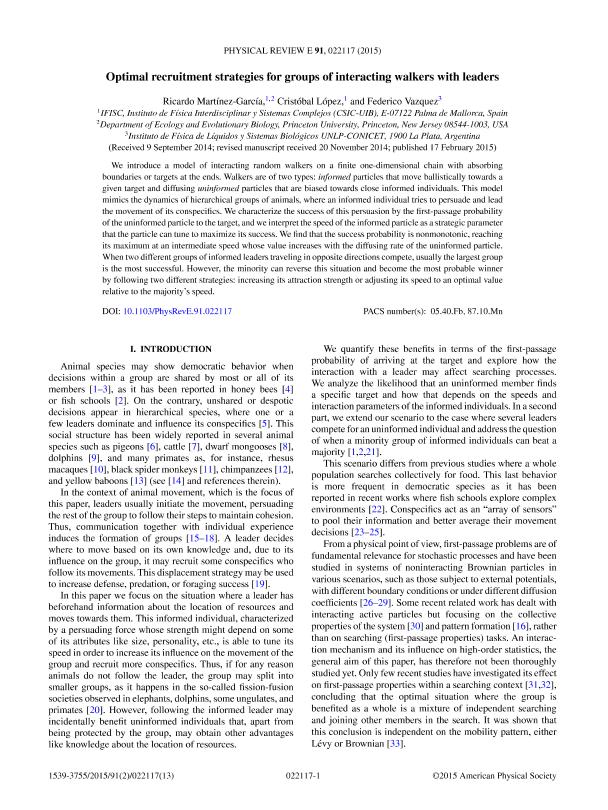Mostrar el registro sencillo del ítem
dc.contributor.author
Martínez García, Ricardo
dc.contributor.author
López, Cristóbal
dc.contributor.author
Vazquez, Federico

dc.date.available
2018-03-12T18:26:16Z
dc.date.issued
2015-02
dc.identifier.citation
Martínez García, Ricardo; López, Cristóbal; Vazquez, Federico; Optimal recruitment strategies for groups of interacting walkers with leaders; American Physical Society; Physical Review E: Statistical, Nonlinear and Soft Matter Physics; 91; 2; 2-2015; 1-13; 022117
dc.identifier.issn
1539-3755
dc.identifier.uri
http://hdl.handle.net/11336/38548
dc.description.abstract
We introduce a model of interacting random walkers on a finite one-dimensional chain with absorbing boundaries or targets at the ends. Walkers are of two types: informed particles that move ballistically towards a given target and diffusing uninformed particles that are biased towards close informed individuals. This model mimics the dynamics of hierarchical groups of animals, where an informed individual tries to persuade and lead the movement of its conspecifics. We characterize the success of this persuasion by the first-passage probability of the uninformed particle to the target, and we interpret the speed of the informed particle as a strategic parameter that the particle can tune to maximize its success. We find that the success probability is nonmonotonic, reaching its maximum at an intermediate speed whose value increases with the diffusing rate of the uninformed particle. When two different groups of informed leaders traveling in opposite directions compete, usually the largest group is the most successful. However, the minority can reverse this situation and become the most probable winner by following two different strategies: increasing its attraction strength or adjusting its speed to an optimal value relative to the majority's speed.
dc.format
application/pdf
dc.language.iso
eng
dc.publisher
American Physical Society

dc.rights
info:eu-repo/semantics/openAccess
dc.rights.uri
https://creativecommons.org/licenses/by-nc-sa/2.5/ar/
dc.subject
Interacting Random Walkers
dc.subject
One-Dimensional Chain
dc.subject
First-Passage Probability
dc.subject
Optimal Recruitment Strategy
dc.subject.classification
Astronomía

dc.subject.classification
Ciencias Físicas

dc.subject.classification
CIENCIAS NATURALES Y EXACTAS

dc.title
Optimal recruitment strategies for groups of interacting walkers with leaders
dc.type
info:eu-repo/semantics/article
dc.type
info:ar-repo/semantics/artículo
dc.type
info:eu-repo/semantics/publishedVersion
dc.date.updated
2018-03-06T17:44:20Z
dc.journal.volume
91
dc.journal.number
2
dc.journal.pagination
1-13; 022117
dc.journal.pais
Estados Unidos

dc.description.fil
Fil: Martínez García, Ricardo. Instituto de Física Interdisciplinar y Sistemas Complejos; España
dc.description.fil
Fil: López, Cristóbal. Instituto de Física Interdisciplinar y Sistemas Complejos; España. University of Princeton; Estados Unidos
dc.description.fil
Fil: Vazquez, Federico. Consejo Nacional de Investigaciones Científicas y Técnicas. Centro Científico Tecnológico Conicet - La Plata. Instituto de Física de Líquidos y Sistemas Biológicos. Universidad Nacional de La Plata. Facultad de Ciencias Exactas. Instituto de Física de Líquidos y Sistemas Biológicos; Argentina
dc.journal.title
Physical Review E: Statistical, Nonlinear and Soft Matter Physics

dc.relation.alternativeid
info:eu-repo/semantics/altIdentifier/doi/http://dx.doi.org/10.1103/PhysRevE.91.022117
dc.relation.alternativeid
info:eu-repo/semantics/altIdentifier/url/https://journals.aps.org/pre/abstract/10.1103/PhysRevE.91.022117
Archivos asociados
